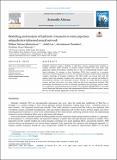| dc.contributor.author | Mushumbusi, Philbert | |
| dc.contributor.author | Leo, Judith | |
| dc.contributor.author | Chaudhari, Ashvinkumar | |
| dc.contributor.author | Masanja, Verdiana Grace | |
| dc.date.accessioned | 2025-04-04T11:38:39Z | |
| dc.date.available | 2025-04-04T11:38:39Z | |
| dc.date.issued | 2025-02-18 | |
| dc.identifier.uri | https://doi.org/10.1016/j.sciaf.2025.e02637 | |
| dc.identifier.uri | https://dspace.nm-aist.ac.tz/handle/20.500.12479/3002 | |
| dc.description | This research article was published in the Scientific African, Volume 28, 2025 | en_US |
| dc.description.abstract | Hydraulic transients remain a challenge in fluid flow systems, spanning basic pipelines to
complex networks. While advances in transient analysis methods have been made, most
approaches require full boundary condition data or rely on computationally intensive mesh
based techniques. In response to these limitations, PINNs have emerged as a promising
alternative for predicting pressure and flow rate transients in pipeline systems without requiring
complete knowledge of boundary conditions. The PINN model was trained both with and
without initial and boundary condition data, achieving results that matched the Method of
Characteristics reference with remarkable accuracy. Notably, the model effectively captured
pressure and flow rate traces, even when tested on data from unmonitored locations. This
demonstrate the robustness of PINN in addressing incomplete data challenges, enhance mesh
free computation, and optimising transient analysis. These findings highlight PINN as a powerful
tool for improving field data accuracy and computational efficiency in hydraulic systems, paving
the way for their broader application in fluid flow networks. | en_US |
| dc.language.iso | en | en_US |
| dc.publisher | Elsevier B. V. | en_US |
| dc.subject | Artificial neural networks | en_US |
| dc.subject | Hydraulic transients | en_US |
| dc.subject | Method of characteristics | en_US |
| dc.subject | Physics-informed neural networks | en_US |
| dc.subject | Water-hammer | en_US |
| dc.title | Modelling and analysis of hydraulic transients in water pipelines using physics-informed neural network | en_US |
| dc.type | Article | en_US |

